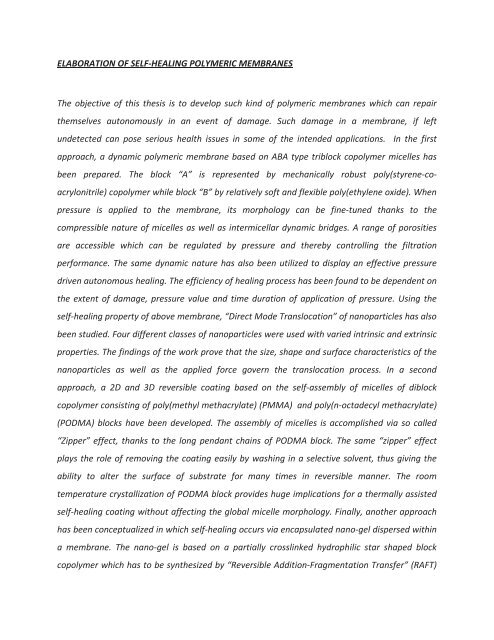4(%3)3 - Ecole nationale supérieure de chimie de Montpellier
4(%3)3 - Ecole nationale supérieure de chimie de Montpellier
4(%3)3 - Ecole nationale supérieure de chimie de Montpellier
You also want an ePaper? Increase the reach of your titles
YUMPU automatically turns print PDFs into web optimized ePapers that Google loves.
ELABORATION OF SELF-HEALING POLYMERIC MEMBRANESThe objective of this thesis is to <strong>de</strong>velop such kind of polymeric membranes which can repairthemselves autonomously in an event of damage. Such damage in a membrane, if leftun<strong>de</strong>tected can pose serious health issues in some of the inten<strong>de</strong>d applications. In the firstapproach, a dynamic polymeric membrane based on ABA type triblock copolymer micelles hasbeen prepared. The block “A” is represented by mechanically robust poly(styrene-coacrylonitrile)copolymer while block “B” by relatively soft and flexible poly(ethylene oxi<strong>de</strong>). Whenpressure is applied to the membrane, its morphology can be fine-tuned thanks to thecompressible nature of micelles as well as intermicellar dynamic bridges. A range of porositiesare accessible which can be regulated by pressure and thereby controlling the filtrationperformance. The same dynamic nature has also been utilized to display an effective pressuredriven autonomous healing. The efficiency of healing process has been found to be <strong>de</strong>pen<strong>de</strong>nt onthe extent of damage, pressure value and time duration of application of pressure. Using theself-healing property of above membrane, “Direct Mo<strong>de</strong> Translocation” of nanoparticles has alsobeen studied. Four different classes of nanoparticles were used with varied intrinsic and extrinsicproperties. The findings of the work prove that the size, shape and surface characteristics of thenanoparticles as well as the applied force govern the translocation process. In a secondapproach, a 2D and 3D reversible coating based on the self-assembly of micelles of diblockcopolymer consisting of poly(methyl methacrylate) (PMMA) and poly(n-octa<strong>de</strong>cyl methacrylate)(PODMA) blocks have been <strong>de</strong>veloped. The assembly of micelles is accomplished via so called“Zipper” effect, thanks to the long pendant chains of PODMA block. The same “zipper” effectplays the role of removing the coating easily by washing in a selective solvent, thus giving theability to alter the surface of substrate for many times in reversible manner. The roomtemperature crystallization of PODMA block provi<strong>de</strong>s huge implications for a thermally assistedself-healing coating without affecting the global micelle morphology. Finally, another approachhas been conceptualized in which self-healing occurs via encapsulated nano-gel dispersed withina membrane. The nano-gel is based on a partially crosslinked hydrophilic star shaped blockcopolymer which has to be synthesized by “Reversible Addition-Fragmentation Transfer” (RAFT)











